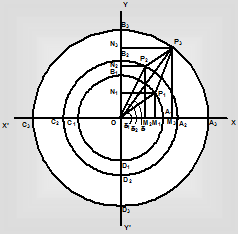Graphical method of finding the resultant of two S.H.M.'s in the same direction when they have the same periodic time: Suppose that a particle N possesses simultaneously two simple harmonic motions about O in the direction YOY′ or the Y axis and the periodic time of each equals T. Let the amplitudes of the two simple harmonic motions be a1 and a2 and their epoch angles and respectively. With O as centre and radii = a1 and a2, draw circles A1B1C1D1 and A2B2C2D2 cutting the axes of X and Y at the points shown in figure. Take the points P1 and P2 on the circumferences of the two circles such that ∠P1OX = δ1 and ∠P2OX = δ2. From P1 and P2 draw P1N1 and P2N2 perpendiculars on YOY′ and P1M1
and P2M2 perpendiculars on XOX′. Then ON1 and ON2 denote the component displacements y1 and y2 of the particle N at the start. With OP1 and OP2 as sides, complete the parallelogram OP1P3P2 and join OP3. Draw P3N3 and P3M3 perpendiculars on YOY′ and XOX′ respectively. The resultant displacement of the particle N on Y-axis at the start is given by ON3. Let this be denoted by y.
Since N2N3 = ON1 = y1
y = ON3 = ON2+N2N3 = y2+y1
With O as centre and radius = OP3, draw the circle A3B3C3D3. Since the components having simple harmonic vibrations have the same periodic time T, the angular velocities OP1 and OP2
will be same and the resultant OP3 will also rotate with the same angular velocity as OP1 or OP2. Thus P3 will always lie on the circumference A3B3C3D3. The resultant motion of the particle N being the projection of uniform circular motion of P3 will therefore, be simple harmonic motion about O along YOY′ with periodic time T. The amplitude of the resultant is given by the diagonal of the parallelogram.
|

The epoch angle of the resultant = d = P3OX is given by


We, therefore, find that the resultant of two simple harmonic motions of equal period in the same direction is another simple harmonic motion of the same period, but of amplitude given by compounding the component amplitudes according to the Parallelogram law.
|

|
Special Cases
(i) When δ1 = δ2 = f, i.e. the two simple harmonic vibrations are in the same phase δ2 - δ1 = 0 and

or 
The resultant vibration has, therefore, in this case, amplitude equal to the sum of the amplitudes of component vibrations and is in phase with each of them.
(ii) When δ2 - δ1 = 180°or component vibrations are opposite in phase then

or a = a1 - a2
and 
or 
The resultant vibration has thus amplitude equal to the difference of amplitudes of component vibrations and is in phase with one of the component vibrations - the one with the bigger amplitude.
Email based Physics assignment help - homework help at Expertsmind
Are you searching physics expert for help with Graphical method of simple harmonic motion questions? Graphical method of simple harmonic motion topic is not easier to learn without external help? We at www.expertsmind.com offer finest service of Physics assignment help and physics homework help. Live tutors are available for 24x7 hours helping students in their Graphical method of simple harmonic motion related problems. We provide step by step Graphical method of simple harmonic motion question's answers with 100% plagiarism free content. We prepare quality content and notes for Graphical method of simple harmonic motion topic under physics theory and study material. These are avail for subscribed users and they can get advantages anytime.
Why Expertsmind for assignment help
- Higher degree holder and experienced experts network
- Punctuality and responsibility of work
- Quality solution with 100% plagiarism free answers
- Time on Delivery
- Privacy of information and details
- Excellence in solving physics queries in excels and word format.
- Best tutoring assistance 24x7 hours